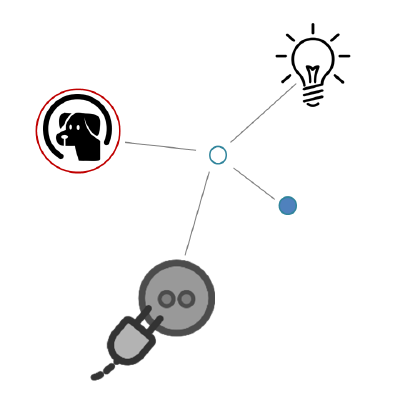Our research projects used and maintained outside academia, mostly open-sourced.
Active: since 2006

The Dog Gateway was firstly developed in 2006, mainly with research purposes. It was targeted at a single home automation technology and had the goal of showing that advanced interaction with home environments was possible. This first version was named BCF, from the Italian words for "It Just Works" (Basta Che Funzioni), to further highlight its transient nature.
From 2007 to 2014, the Dog gateway has been developed and improved embedding more features, integrating new home, building and industrial automation technologies, providing a single uniform device abstraction layer based on Semantic Web technologies (the DogOnt ontology). In these years, 3 major versions have been released, the 3.0 being the latest.
Nowadays, the Dog Gateway is an open source, OSGi compliant implementation of smart environment gateway and IoT platform featuring multi-protocol capabilities, REST-based application APIs, uniform device representation, rule-based activations, real-time data elaboration (with complex event processing technologies), Xively integration (to enable social sharing of consumptions and activations), etc.
Active: since 2008
 DogOnt was originally meant to represent home automation devices for interoperability support. In the past years it underwent several reviews and amendments, and its scope was widened to include devices and technologies typically part of an indoor IoT network.
DogOnt was originally meant to represent home automation devices for interoperability support. In the past years it underwent several reviews and amendments, and its scope was widened to include devices and technologies typically part of an indoor IoT network.
If the original focus was more on modeling operational aspects enabling device control, the latest version has moved to a more informed, modular and linked modeling approach which enables adoption of DogOnt-based representations at different abstraction layers. While device control and interoperability is still one of the pillars of the representation, extensibility, modularity and service-based representation of IoT entities empower the latest ontology, enabling modular integration and reconciliation of different specifications, e.g., the cluster-based ZigBee Home Automation model and the registry-based Modbus data representation.
More attention is also devoted to the Linked Open Data initiative: the ontology is now listed in the Linked Open Vocabulary data set and its connections with well-known ontologies are being improved day by day. Moreover, DogOnt was among the most important sources used in the creation of the SAREF ETSI standard.

